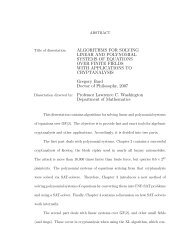Cryptography - Sage
Cryptography - Sage
Cryptography - Sage
Create successful ePaper yourself
Turn your PDF publications into a flip-book with our unique Google optimized e-Paper software.
IIHDYOOWSAEONUAPVCNTGSIEKDHHREYSEESIDUARBADSHICOIIOUDUWLNMNBTLOGEDOTIROLEYHNSNARSEEDTNSFEWOHDTONEWEIARGSHMYNGIAEAEDENNNYLWTEGTFLHTSTHLEOHCHEODCEHAYWFAWATAEOMHNMRRREAGEEWCRLELFHAUETOAEPNLHDRNTNOEYAIAIOSLWTINKAIAHNGOIKYOATNLEAUROOHATGATVALSHBHEULETIERLTASimple columnar transpositions impose unnecessarily restrictive conditions on the form ofthe transposition, but were widely used as a component of ciphers used until the 1950’s.More general columnar transpositions allow for permuations of the columns before readingthem off.General transposition ciphersA general transposition cipher of block length m allows m! different permuations.m = 7, this is a mere 5040 permutations, but for block length 36, this givesFor371993326789901217467999448150835200000000possibilities. One such permutation, given in cycle notation, is:(1, 12, 5, 36, 30, 31, 4, 28, 33, 22, 26, 17, 10, 16, 14, 23, 18, 35, 32)(2, 9, 3, 25, 15, 7, 21, 6, 29, 34, 11, 27, 19, 24)(8, 13, 20).Applied to the above ciphertext this gives a the ciphertextNNWNTIOTAMERLEDHGHRIIHYWEAFUGHSIWOOTAMCTIADNPYPEEOSDEBRODALSIELRANIIFLAIRNRNEICSVNNYOMHTDHEUUUWAADHOTGEHAETNSBLOROEFCGLSHHIOOEADAETERETOVOKDWYNKETEELSHENIHECNCNTUGURTEOGNSHAIDYAHLAELLYTLAWTADEHMOEILEWBOGNSNTALKHOTNEIDOFAAWYOGERSERIWREELAATUHNHTSYHOASAADespite the large number of possible permutations, the unmasked stucture of the plaintextpermits an adversary to decipher transposition ciphertext.16 Chapter 2. Classical <strong>Cryptography</strong>
















